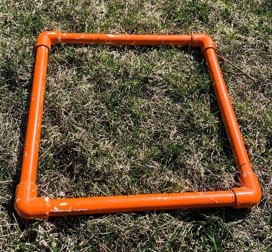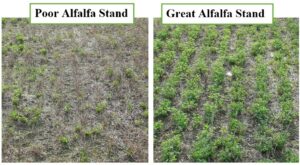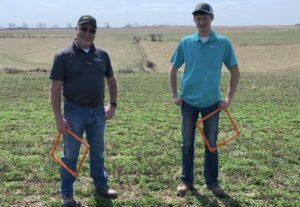Spring is here and if you look out into the fields, you will start to see some green popping up. Now is time to assess the alfalfa stand condition. First, you will need a square to measure a square foot; as in the picture below.
Just plop this down in a couple of random spots throughout the field and start counting. One way to count the alfalfa stand condition is to count the individual plant. A high-yielding alfalfa stand seeded last year should have 20 plants/ft2. Counts as low as 12 plants/ft2 will produce a good yield, but result in shortened stand life. Anything less than 12 plants/ft2, will have lower yields and start to lose profitability. A high-yielding alfalfa stand over 1 year old, should have at least 6 plants/ft2. If plant density is less than 6 plants/ft2, the fields begin to lose profitability. Another way to count the alfalfa stand condition is to count the individual stems. A healthy stand should have 55 stems/ft2. If stem counts are between 40 to 55stems/ft2, stem density might be limiting yield potential. Anything below 40stems/ft2, will begin to lose profitability.
A solution to a Low Yielding Alfalfa Stand
So what do we do when the field is below 40stems/ft2 and below 12 plants/ft2? One option is to rotate out of alfalfa. Some farmers probably want other options available. Thin, open stands, lower yield, and invite weed invasion, which lowers feed value and marketability.
Inter-seeding or over-seeding can be some options to bring up the field yield for this year. Over-seeding red clover or Italian ryegrass can prolong the life of damaged alfalfa stand by up to two years. Small grains and annual cool grasses (oats, wheat, rye, triticale, or annual ryegrass) can provide high-quality forage quickly and effectively prolong stand life for one year. Inter-seeding perennial grasses, such as orchard grass, teff, timothy, or tall fescue takes longer to establish, than annual grasses but can enhance stands for two or more years. Best success with inter-seeding is to seed with a no-till drill. Grass and clover can be drilled early in the spring if alfalfa is still small enough. Once surviving alfalfa has reached 6-8 inches in height, it is extremely competitive with grass seedlings, and it will be more effective to drill new seeds immediately after the first harvest. Alfalfa stands can tell us a lot and can save the farmer field profitability by taking action now.
Check out this video featuring Bob Johnson (Sales Consultant) and Ben Acheson (Intern), as they demonstrate how to do an alfalfa stand assessment.
Watch on YouTube: https://www.youtube.com/watch?v=iVfJwoc6l9o
A Bit About Forage Rotation
Bob Bellmeyer has a small farm in southwestern Wisconsin, where he successfully grows alfalfa as a cash crop. Despite less-than-ideal ground, Bob consistently achieves good yields using the Midwestern BioAg program: hay over six tons per acre, corn at 185 bu/acre, and soybeans at 50 bu/acre.
Bob uses a three-crop rotation: soybeans, corn, and hay. He seeds about 10 acres per year with a nurse crop of oats, often finding it a challenge to combine the oats before the hay gets too big. “The hay grows too well,” Bob notes.
Bob has used Bio-Cal® for the past 10 years to raise the calcium content of his soil and maximize alfalfa yields. He also uses short rotations (keeping a field in hay for no more than four years) and applies 300 lbs/acre of 3-10-25.
“It’s as good a program as there is,” Bob says of Midwestern BioAg’s forage program. “If you stick with the program, your soil improves.”




